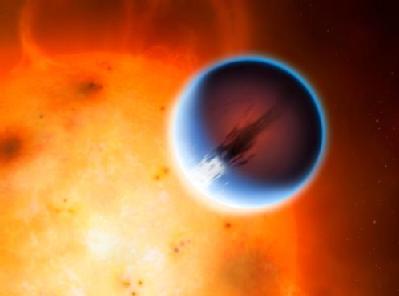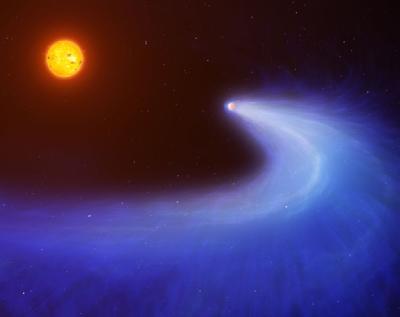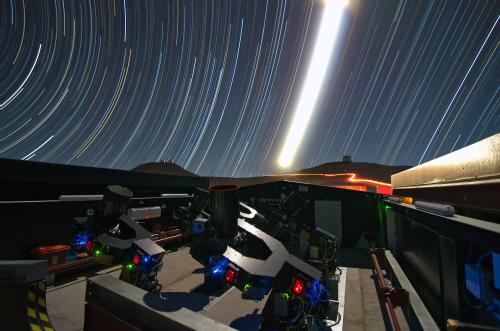Exoplanet Atmospheres PhD Project
Mapping the climate systems and the evaporation of exoplanet atmospheres
Supervisor: Prof. Peter Wheatley
For this project you will use data from ground-based and space telescopes to explore the atmospheres of transiting exoplanets. This includes the composition of the atmosphere, the formation of climate and weather systems including winds and clouds, and the evaporation of atmospheres irradiated by X-rays from the parent star. You will also have the opportunity to contribute to the discovery of new exoplanets in wide orbits around their parent stars.
Please contact me directly to find out more.
Mapping atmospheric composition and climate systems
We can probe the 3D structure and composition of planetary atmospheres using the technique of transmission spectroscopy, where opacity sources in the planetary atmosphere are detected in high-precision spectra taken during a transit of the planet across the face of its parent star. This can reveal the presence of specific atoms and molecules in the planetary atmosphere, as well as clouds and photochemical hazes. With transmission spectroscopy at high spectral resolution we can also detect Doppler shifts due to winds in the planetary atmosphere, and begin to map global climate systems.
Recently-discovered exoplanets around bright stars, together with new more powerful instruments such as ESPRESSO and the James Webb Space Telescope (JWST), provide exciting new opportunities to map the 3D structure of exoplanet atmospheres. This goal builds on our own pioneering work with the HARPS spectrograph (see figure below). A main goal of the PhD project will be to map the climate systems of hot, giant planets, thereby testing 3D models of global circulation.
|
|
Artist's impression of our original discovery of a high-speed eastward wind around the equator of the hot Jupiter HD189733b. With my former PhD student, Tom Louden, we used the high-resolution HARPS spectrograph in Chile to resolve the Doppler shifts of each side of the planet. This discovery confirmed predictions from global climate models that the intense heating of the planet would drive an eastward jet in the atmosphere. It was the first time that the 3D structure of an exoplanet had been spatially resolved. You can read the full journal article here and the Warwick press release here. (c) Mark Garlick and University of Warwick. |
Mapping X-ray-driven atmospheric evaporation
The same transmission spectroscopy techniques can be used to map the 3D structure of gas escaping from planetary atmospheres. We have directly detected the evaporation of some exoplanet atmospheres using transmission spectroscopy (see figure below) and it has become clear that the observed population of close-in exoplanets is severely influenced by the evaporation of their atmospheres. In particular, we see very few planets of Neptune-size close-in to their parent stars, a region that has become known as the Neptune desert. Further out, we also see a deficit of planets between the size of Earth and Neptune, known as the evaporation valley. A goal of this project will be to apply the same technique of transmission spectroscopy to trace the mass loss of planetary atmospheres using the Doppler shift of an infrared helium line and possibly X-ray absorption.
The cause of the atmospheric evaporation is hotly debated, with some scientists suggesting this is due to heating by X-rays emitted from the parent star, and other researchers arguing that the main source of energy comes from the core of the planet. We can test these ideas by directly measuring the X-ray emission of exoplanet host stars, and relating the X-ray irradiation of the planetary atmosphere to its measured and inferred mass loss. We will do this using ESA's XMM-Newton space telescope and NASA's Chandra mission. A goal of this project is to model the resulting mass loss over the lifetime of the exoplanets in order to assess whether X-ray driven evaporation is sufficient to explain the Neptune desert and the evaporation valley. In particular, we will focus on planetary systems where some planets have been evaporated down to their bare core, while others retain at least some of their atmosphere. These systems provide the most sensitive tests of atmospheric evaporation mechanisms.
|
|
Artist's impression of our discovery of a comet-like tail of hydrogen gas escaping the atmosphere of the Neptune-sized planet GJ436b. The atmospheric escape is thought to be driven by irradiation of the atmosphere by X-rays from the corona of the host star. Neptune-sized planets are particularly sensitive to atmospheric escape, and close-in hot Neptunes may be evaporated to destruction leaving behind a small rocky core. You can read our full journal article here and the Warwick press release here. (c) Mark Garlick and University of Warwick. |
Discovery of wide-separation transiting exoplanets with cool atmospheres
By combining observations with our own telescopes of the Next Generation Transit Survey in Chile with data from NASA's TESS spacecraft we can find cool exoplanets in wide orbits around their host stars (see figure below). These new discoveries allow us to study planetary atmospheres that are not intensely irradiated by their parent star, making them good analogues for habitable exoplanets. These new planets also provide a connection between exoplanet atmospheres and the relatively well understood atmospheres of the planets in our own Solar System. As part of this project you will have the opportunity to contribute to the detection and interpretation of these new exoplanets.
|
|
Photograph of some of the telescopes of the Next Generation Transit Survey in Chile, which we use to search for new transiting exoplanets. I lead this project and we control the telescopes from Warwick. With my postdoc, Sam Gill, we discovered a Saturn-sized exoplanet in a wide orbit around its parent star. Studying the atmospheres of these relatively cool exoplanets provides a connection to habitable exoplanets and the planets in our own Solar System. You can read the full journal article here and the Warwick press release here.
|



